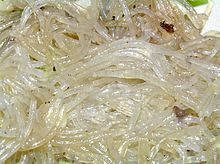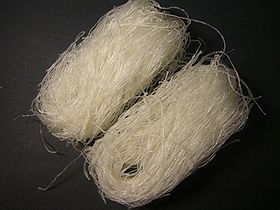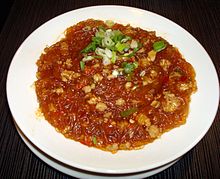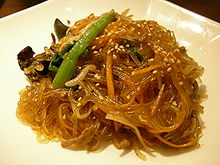- Cellophane noodles
-
Cellophane noodles Dried cellophane noodles Chinese name Traditional Chinese 1. 粉絲
2. 冬粉
3. 細粉
4. 線粉Simplified Chinese 1. 粉丝
2. 冬粉
3. 细粉
4. 线粉Literal meaning 1. powder thread
2. winter powder
3. slender powder
4. line powderTranscriptions Mandarin - Hanyu Pinyin 1. fěnsī
2. dōngfěn
3. xìfěn
4. xiànfěnMin - Hokkien POJ 2. tang-hún Cantonese (Yue) - Jyutping 1. fan2 si1
2. dung1 fan2
3. zi2 fan2
4.sin3 fan2Japanese name Kanji 春雨 Transcriptions - Romaji harusame Korean name Hangul 당면 Hanja 唐麵 Transcriptions - Revised
Romanizationdangmyeon Thai name Thai วุ้นเส้น RTGS wóon sên Vietnamese name Vietnamese 1. miến
2. bún tàu
3. bún tàoCellophane noodles (also known as Chinese vermicelli, bean threads, bean thread noodles, crystal noodles, or glass noodles) are a type of transparent noodle made from starch (such as mung bean starch, yam, potato starch, cassava or canna starch), and water.
They are generally sold in dried form, boiled to reconstitute, then used in soups, stir fried dishes, or spring rolls. They are called "cellophane noodles" or "glass noodles" because of their appearance when cooked, resembling cellophane, a clear material or a translucent light gray or brownish-gray color.
Cellophane noodles are generally round, and are available in various thicknesses. Wide, flat cellophane noodle sheets called mung bean sheets are also produced in China.
Cellophane noodles should not be confused with rice vermicelli, which are made from rice and are white in color rather than clear (after cooking in water).
Contents
In China
Naming
 Cellophane noodles have a translucent appearance when cooked. It is generally much longer than rice vermicelli.
Cellophane noodles have a translucent appearance when cooked. It is generally much longer than rice vermicelli.
In Chinese, the most commonly used names are:
- fěn sī (simplified Chinese: 粉丝; traditional Chinese: 粉絲): with fěn meaning "powder" and sī meaning "thread"
- dōng fěn (Chinese: 冬粉): with the literal meaning of "winter powder"
They are also marketed under the name saifun, the Cantonese pronunciation of the Mandarin xì fěn (Chinese: 細粉; literally "slender powder"), though the name fan2 si1 (粉絲) is the term most often used in Cantonese. While by itself the character fěn (Chinese: 粉) means powder, it etymology is probably related to diàn fěn (simplified Chinese: 淀粉; traditional Chinese: 澱粉), which means "starch" — the substance from which the noodles are made.
Production
In China, the primary site of production of cellophane noodles is the town of Zhangxing, in the city of Zhaoyuan (simplified Chinese: 招远市; traditional Chinese: 招遠市), which is administered by the prefecture-level city of Yantai, in the eastern province of Shandong. However, historically, the noodles were shipped through the port of Longkou (which is also under the administration of Yantai), and thus the noodles are known and marketed as Longkou fensi (simplified Chinese: 龙口粉丝; traditional Chinese: 龍口粉絲).[1]
Use
In China, cellophane noodles are usually made of mung bean starch and are a popular ingredient used in stir fries, soups, and particularly hot pots. They can also be used as an ingredient in fillings for a variety of Chinese jiaozi (dumplings) and bing (flatbreads), especially in vegetarian versions of these dishes. Thicker cellophane noodles are also commonly used to imitate the appearance and texture of shark's fin in vegetarian soups. Thicker varieties, most popular in China's northeast, are used in stir fries as well as cold salad-like dishes. A popular soup using the ingredient is fried tofu with thin noodles (simplified Chinese: 油豆腐线粉汤; traditional Chinese: 油豆腐線粉湯; Pinyin: yóu dòu fu-xiàn fěn tāng). A popular Sichuan dish called ants climbing a tree (simplified Chinese: 蚂蚁上树; traditional Chinese: 螞蟻上樹; Pinyin: má yǐ shàng shù) consists of stewed cellophane noodles with a spicy ground pork meat sauce.
Health concerns
In 2004, testing by Chinese authorities determined that some brands of cellophane noodles produced in Yantai, Shandong were contaminated with lead. It emerged that several unscrupulous companies were making their noodles from cornstarch instead of mung beans in order to save costs, and, to make the cornstarch transparent, were adding lead-based whiteners to their noodles.[2] In December 2006, Beijing authorities again inspected cellophane noodles produced by the Yantai Deshengda Longkou Vermicelli Co. Ltd. in Siduitou village, Zhangxing town, Zhaoyuan city, Yantai, this time determining that sodium formaldehyde sulfoxylate, a toxic and possibly carcinogenic industrial bleach that is an illegal food additive in China, had been used in the production of the noodles. The company, which formerly sold its noodles both in China as well as overseas, was ordered to cease production and distribution.[3][4][5][6]
In December 2010, Czech food inspection authorities (SZPI) again inspected Chinese cellophane noodles, this time determining that 142.00 mg/kg of aluminium, which is an illegal amount for food in Czech (and EU) market, had been used in the production of the noodles.[7]
Outside China
In Indonesian cuisine, they are called soun or suun.
In Malaysia they are known as tanghoon (冬粉). People sometimes confuse them with bihun (米粉) which are rice vermicelli.
In Philippine cuisine, the noodles are called a similar name: sotanghon because of the popular dish of the same name made from them using chicken and wood ears[disambiguation needed
 ]. Like in Malaysia, they are also confused with rice vermicelli, which are called bihon in the Philippines.
]. Like in Malaysia, they are also confused with rice vermicelli, which are called bihon in the Philippines.In Japanese cuisine, they are called harusame (春雨), literally "spring rain." Unlike Chinese glass noodles, they are usually made from potato starch. They are commonly used to make salads, or as an ingredient in hot pot dishes. They are also often used to make Japanese adaptations of Chinese and Korean dishes.
In Tibetan cuisine, glass noodles are called phing or fing and are used in soup, pork curry or with mushrooms.
In India and Pakistan, glass noodles are called falooda (see Faludeh from Persian cuisine), and are served on top of kulfi (a traditional ice cream). They are usually made from arrowroot starch using a traditional technique. The noodles are flavorless so provide a nice balance with the sweet kulfi. Kulfi and falooda can be bought from numerous food stalls throughout Pakistan and northern parts of India.
In Korean cuisine, glass noodles are usually made from sweet potato starch and are called dangmyeon (Hangul: 당면; Hanja: 唐麵; literally "Tang noodles"; also spelled dang myun, dangmyun, tang myun, or tangmyun). They are commonly stir-fried in sesame oil with beef and vegetables, and flavoured with soy and sugar, in a popular dish called japchae (hangul: 잡채). They are usually thick, and are a brownish-gray color when in their uncooked form.
In Vietnamese cuisine, there are two varieties of cellophane noodles. The first, called bún tàu or bún tào, are made from mung bean starch, and were introduced by Chinese immigrants. The second, called miến or miến dong, are made from canna (Vietnamese: dong riềng), and were developed in Vietnam. These cellophane noodles are a main ingredient in the dishes: miến gà, miến lươn, miến măng vịt, and miến cua. These cellophane noodles are sometimes confused with rice vermicelli (Vietnamese: bún) and arrowroot starch noodles (Vietnamese: arrowroot: củ dong, arrowroot starch: bột dong/bột hoàng tinh/bột mì tinh).
In Thai cuisine, glass noodles are called wun sen (Thai: วุ้นเส้น). They are commonly mixed with pork and shrimp in a spicy salad called yam wun sen (Thai: ยำวุ้นเส้น), or stir-fried as phat wun sen (Thai: ผัดวุ้นเส้น).
In Hawaii, where cuisine is heavily influenced by Asian cultures, cellophane noodles are known locally as long rice, supposedly because the process of making the noodles involves extruding the starch through a potato ricer.[8] They are used most often in chicken long rice, a dish of cellophane noodles in chicken broth that is often served at luaus.[9] Glass noodles were introduced to Samoa by Cantonese agricultural workers in the early 1900's where they became known as "lialia," a Samoan word meaning "to twirl," after the method of twirling the noodles around chopsticks when eating. A popular dish called "sapasui" (transliteration of the Cantonese chop suey) is common fare at social gatherings. Sapasui, a soupy dish of boiled glass noodles mixed with braised pork, beef, or chicken and chopped vegetables, is akin to Hawaiian "long rice."
See also
References
- ^ "China Vermicelli Manufacturer - Yantai Yinsida Longkou Vermicelli Co., Ltd.". made-in-china.com. http://www.made-in-china.com/import-export/umnEfQJVBxdZprofile1/Yantaiyinsida-Longkou-Vermicelli-Co-Ltd-.html.
- ^ "Dubious Noodles on Shelves". China Internet Information Center. May 8, 2004. http://www.china.org.cn/english/BAT/94745.htm.
- ^ "Cancer-scare Noodles still on the market". Shanghai Daily (CRIENGLISH.com). 2006-12-07. http://english.cri.cn/2946/2006/12/07/48@171620.htm.
- ^ "Poisonous Vermicelli Found in Beijing". The Epoch Times. Dec 14, 2006. http://en.epochtimes.com/news/6-12-14/49354.html.
- ^ "问题粉丝可能是冒牌货 烟台质监局已介入调查" (in Chinese). health.enorth.com.cn. 2006-12-08. http://health.enorth.com.cn/system/2006/12/08/001484607.shtml.
- ^ "Archive for the ‘Food’ Category". Status of Chinese People. WordPress.com. http://chinaview.wordpress.com/tag/life/food/.
- ^ http://www.szpi.gov.cz/docDetail.aspx?docid=1027641&docType=ART&nid=11343
- ^ Keiko Ohnuma (Apr 25, 2007). "The choice is clear". Honolulu Star-Bulletin. Archived from the original on June 14, 2008. http://web.archive.org/web/20080614015714/http://starbulletin.com/2007/04/25/features/story01.html.
- ^ "Chicken Long Rice". 'Ono Kine Grindz. TypePad. October 27, 2005. http://onokinegrindz.typepad.com/ono_kine_grindz/2005/10/chicken_long_ri.html.
External links
Chinese noodles Ants climbing a tree • Ban mian • Beef chow fun • Beef noodle soup • Biángbiáng noodles • Cart noodle • Cellophane noodles • Champon • Char kway teow • Chow mein • Cu mian • Crossing the bridge noodles • Dan dan noodles • Henan braised noodles • Hokkien mee • Jook-sing noodles • Ka tieu • Lamian • Lai fun • Liang pi • Lo mein • Mee pok • Mi xian • Millinge • Misua • Mung bean sheets • Oil noodles • Re gan mian • Rice noodles • Rice vermicelli • Saang mein • Satay bee hoon • Shahe fen • Shanghai fried noodles • Shrimp roe noodles • Silver needle noodles • Wonton noodles • Yi mein • You mian • Zha jiang mianCategories:- Noodles
- Chinese noodles
- Philippine cuisine
- Japanese ingredients
- Korean noodles
- Vietnamese noodles
Wikimedia Foundation. 2010.




